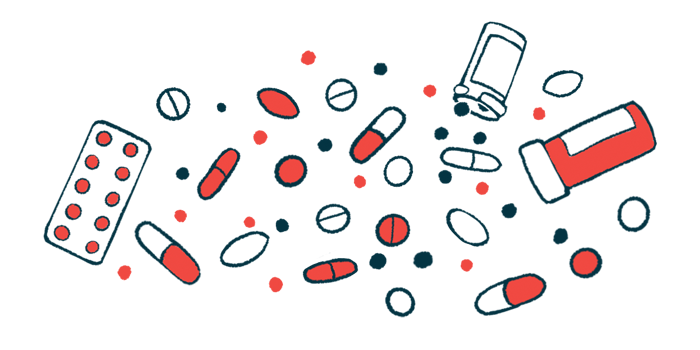Study confirms Takhzyro’s long-term benefits for HAE patients
Treatment for 3 years led to fewer, less severe attacks

Hereditary angioedema (HAE) patients who took Takhzyro (lanadelumab-flyo) for at least three years saw reductions in the frequency and severity of attacks and found that their quality of life improved, data from a U.S. study showed.
The study, “Long-term Real-world Outcomes in Patients with Hereditary Angioedema Receiving Lanadelumab for 3 or More Years,” was published in the International Archives of Allergy and Immunology.
HAE is characterized by sudden and recurring episodes of swelling in the deeper layers of the skin and mucus membranes. The condition primarily results from genetic mutations in the SERPING1 gene, which encodes a protein called C1-inhibitor (C1-INH). This protein plays a crucial role in inhibiting the production of bradykinin, a pro-inflammatory molecule that can induce swelling. When C1-INH levels are too low (HAE type 1) or the protein doesn’t function correctly (HAE type 2), bradykinin levels can rise too high, leading to swelling attacks.
Takhzyro, marketed by Takeda, is an antibody that inhibits the action of plasma kallikrein, an enzyme involved in bradykinin production. Administered as an under-the-skin (subcutaneous) injection, Takhzyro is approved as a first-line treatment for preventing swelling attacks in patients ages 2 and older in the U.S. and EU and those ages 12 and older in multiple other regions.
Takhzyro’s approvals were supported by clinical trial data showing the therapy could safely prevent and reduce the frequency of swelling attacks. However, “real-world data on long-term [Takhzyro] use in patients with HAE are limited,” the researchers said.
Retrospective analysis finds treatment’s benefits begin quickly, last over time
The team, led by researchers at Takeda, retrospectively analyzed data from a survey conducted from January 2023 to January 2024, focusing on U.S. patients treated with Takhzyro for at least three years.
The analysis involved data from 51 patients (60.8% men, mean age of 35.8) who were treated with Takhzyro for a mean of 4.6 years, as reported by 18 physicians. Most patients had HAE type 1 (82.4%), and 72.5% were prescribed on-demand treatment in addition to Takhzyro, with 78.4% receiving icatibant (sold as Firazyr, generics).
More than half of the patients (66.7%) had not received long-term preventive treatment prior to Takhzyro. About a third (27.5%) had tried one prior treatment, while 5.9% had been on two. Prior treatments included Cinryze (58.8%), Haegarda (17.6%), danazol (11.8%), and tranexamic acid (5.9%).
According to the physicians, common reasons for discontinuing previous long-term preventive therapy included inconvenient dosing schedules, insufficient effectiveness in reducing attack frequency, and patient preference for alternative routes of administration.
Before starting treatment with Takhzyro, 46% of patients reported having no monthly attacks, while 38% experienced one attack per month, 14% had two to three, and 2% had more than three.
At the time of the survey, 9.8% of patients experienced at least one attack per month, a marked reduction from the 54% reporting monthly attacks before starting treatment with Takhzyro. The proportion of patients who remained attack-free increased over the course of treatment with Takhzyro, reaching 55.1% after three years.
Attack severity also diminished following treatment with Takhzyro. The percentage of patients experiencing very severe attacks decreased from 8.2% before treatment to 4.3% after one year, and to 2.1% after two years.
In the year leading up to the survey, 7.3% of patients were hospitalized due to HAE attacks. Among those assessed after initiating Takhzyro, 63.3% saw fewer hospitalizations. The remaining 36.7% were never hospitalized.
Physicians reported that 88.2% of patients had good or excellent quality of life (QoL) at the time the survey was taken, up from 68.6% before treatment. The percentage of patients reporting excellent QoL increased from 19.6% after one year of treatment to 35.3% after two years and to 56.9% by the third year.
Prior to Takhzyro, 17.6% of patients had poor or very poor QoL, according to the physicians. After one year of treatment, this was no longer reported in any patient, a trend that continued over the following two years.
Overall, the findings are “consistent with real-world studies that have reported notable reductions in attack rates and severity and improvements in QoL after 6 months of [Takhzyro] treatment, and sustained well-controlled disease in patients who had been receiving [long-term prophylaxis] for 4 years,” the researchers wrote.
“Taken with findings presented here, results suggest that the clinical benefit of [Takhzyro prophylaxis] can occur soon after treatment initiation and be maintained long-term in real-world settings,” they wrote.







